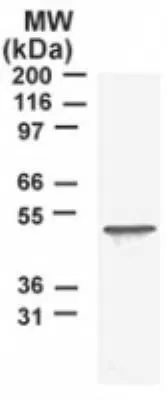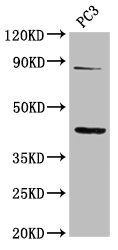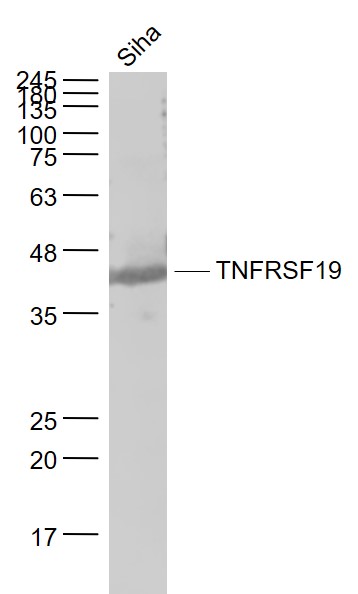
WB analysis of T98G cell lysate using GTX12126 TROY antibody.
TROY antibody
GTX12126
ApplicationsWestern Blot, ImmunoHistoChemistry
Product group Antibodies
TargetTNFRSF19
Overview
- SupplierGeneTex
- Product NameTROY antibody
- Delivery Days Customer9
- Application Supplier NoteWB: 0.5 - 2 microg/ml. *Optimal dilutions/concentrations should be determined by the researcher.Not tested in other applications.
- ApplicationsWestern Blot, ImmunoHistoChemistry
- CertificationResearch Use Only
- ClonalityPolyclonal
- Concentration0.5 mg/ml
- ConjugateUnconjugated
- Gene ID55504
- Target nameTNFRSF19
- Target descriptionTNF receptor superfamily member 19
- Target synonymsTAJ; TAJ-alpha; toxicity and JNK inducer; TRADE; TROY; tumor necrosis factor receptor superfamily member 19
- HostRabbit
- IsotypeIgG
- Protein IDQ9NS68
- Protein NameTumor necrosis factor receptor superfamily member 19
- Scientific DescriptionThe protein encoded by this gene is a member of the TNF-receptor superfamily. This receptor is highly expressed during embryonic development. It has been shown to interact with TRAF family members, and to activate JNK signaling pathway when overexpressed in cells. This receptor is capable of inducing apoptosis by a caspase-independent mechanism, and it is thought to play an essential role in embryonic development. Alternatively spliced transcript variants encoding distinct isoforms have been described. [provided by RefSeq]
- Storage Instruction-20°C or -80°C,2°C to 8°C
- UNSPSC12352203
References
- Expression of Protein-Coding Gene Orthologs in Zebrafish and Mouse Inner Ear Non-sensory Supporting Cells. Giffen KP et al., 2019, Front NeurosciRead more





